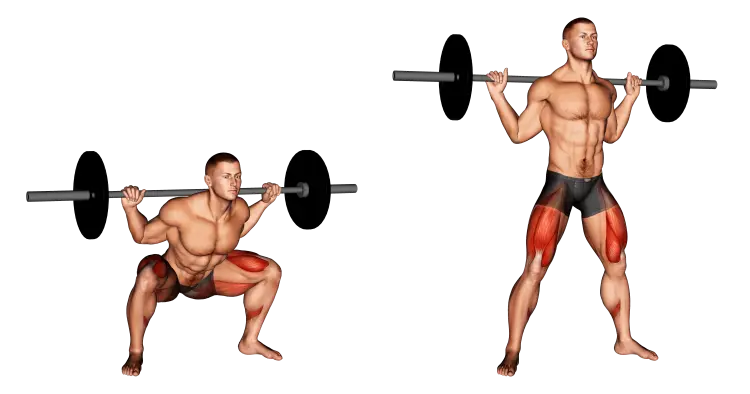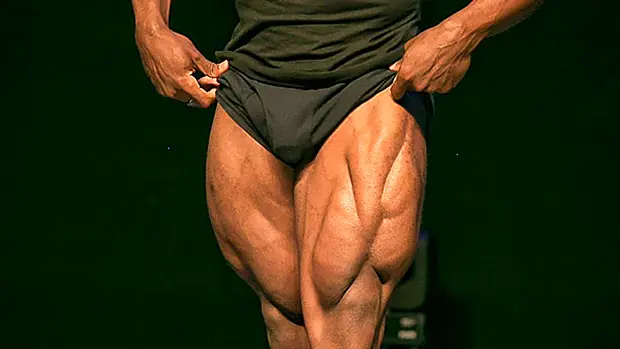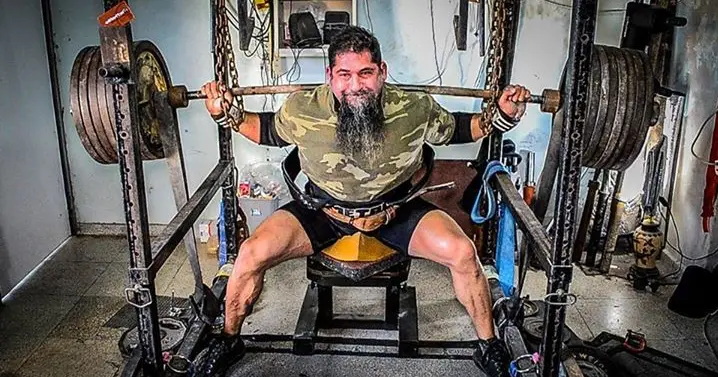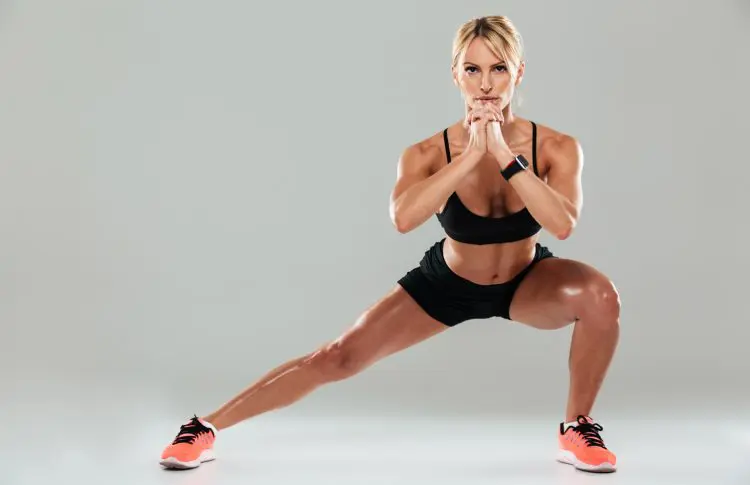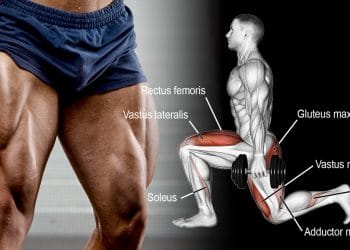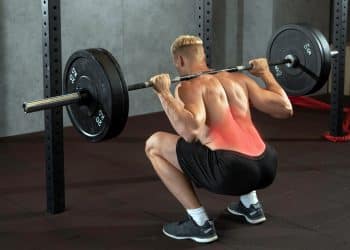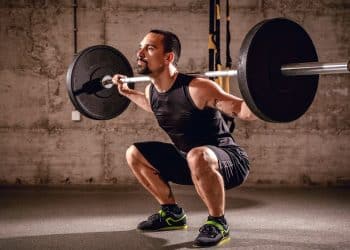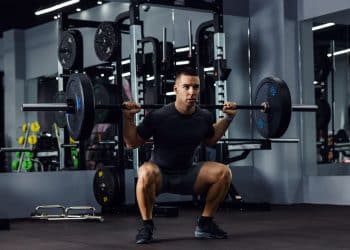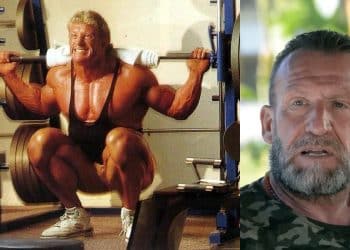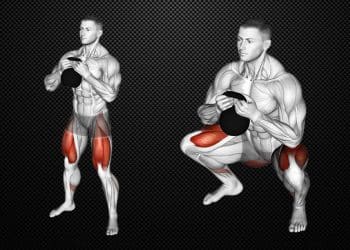Whatever your training goals are, squats are a must. It doesn’t matter if you want to sculpt massive bodybuilder’s thighs, run faster, jump higher, lift heavier, or just build a bigger butt and shapelier legs, you’ll get there sooner if squats are part of your workouts.
There are lots of different types of squats to choose from, and they’re all very useful. But the variations tend to differentiate based on how or where you hold the load. There are front squats, back squats, zercher squats, overhead squats, and dumbbell squats to choose from.
However, unless you make a conscious effort to move your feet, most people tend to use the same stance for all types of squat – with their feet somewhere between hip and shoulder-width apart. This probably feels comfortable and is based on habit; it’s just the stance you automatically use.
But there are some benefits to be had by stepping out into a wider than normal stance, including increased muscle activation, less joint stress, and better lifting mechanics. Yes, squatting with a wider stance will feel odd at first, but that doesn’t mean you shouldn’t try it.
This article discusses the benefits of wide stance squats and reveals the best alternatives to this productive exercise.
Wide Squat Stance – Muscles Worked
Most lifters already know the muscles that squats work, i.e., all the muscles of the lower body, plus several in the upper body too. But, just in case you need an anatomy refresher, the main muscles used in wide stance squats are:
Level Up Your Fitness: Join our 💪 strong community in Fitness Volt Newsletter. Get daily inspiration, expert-backed workouts, nutrition tips, the latest in strength sports, and the support you need to reach your goals. Subscribe for free!
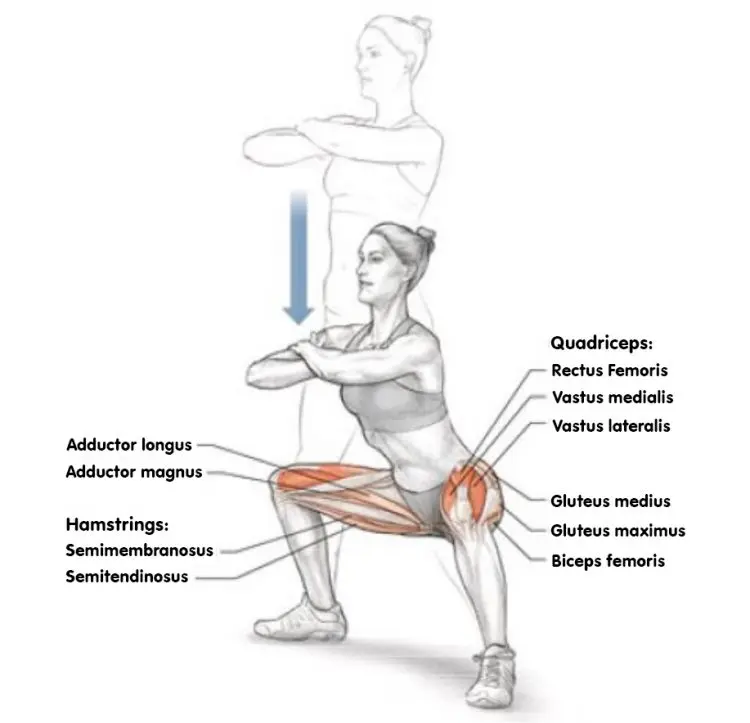
Quadriceps – located on the front of your thighs, the quads are actually four muscles that extend your knee and flex your hips. The four quadriceps are the rectus femoris, vastus lateralis, vastus medialis, and vastus intermedius. Squats are a very quad-centric exercise. In fact, it’s your quads you’ll feel doing most of the work.
Hamstrings – opposite your quadriceps, the hamstrings flex your knees and extend your hips. There are three hamstring muscles; biceps femoris, semimembranosus, and semitendinosus. The deeper you squat, the more active your hamstrings are.
Gluteus maximus – known as your glutes for short and located on the back of your hips, this is the largest and potentially strongest muscle in the human body. Its primary function is the extension of the hip.
Hip abductors – located on the outside of your hip and thigh, the abductors pull your femurs outward. They’re more active in wide stance squats than the narrower variation. The hip abductors are gluteus minimus and medius, and tensor fascia latae, or TFL for short.
Hip adductors – adductor longus, brevis, and magnus are located on the inside of your thigh. They pull your femurs inward. Using a wide stance increases the range of motion of these muscles and increases inner thigh activation.
Core – doing squats with weights increases core activation. Your core works hard to stabilize your spine so that your midsection doesn’t collapse under the heavier load. The muscles that make up your core include rectus abdominus, obliques, transversus abdominus, pelvic floor, diaphragm, and erector spinae.
How to Perform Wide Stance Squats
There are two ways to do most exercises – the wrong way and the right way. The wrong way often feels a little easier and may even allow you to lift more weight. However, it’s usually harder on your joints and more likely to lead to injury.
The right way puts more tension on the target muscles and keeps the risk of injury to a minimum.
Make sure you do wide stance squats correctly to get the most from this exercise. Start with a light weight and get used to squatting with your feet further apart than usual. Also, be prepared for some new and unusual delayed onset muscle soreness, even if you are an experienced squatter. You’ll probably feel this exercise in your abductors, adductors, and glutes more than usual, especially a day or so afterward.
How to do it:
- Place a barbell in a squat rack, so the bar is about shoulder-level. Grab the bar with a slightly wider than shoulder-width grip and duck under it. Press your upper back against the bar, so it sits on your traps and NOT your neck. Brace your abs and pull your shoulders down and back.
- Lift the bar off the supports and take 1-2 steps back. Move your feet out so that they are wider than shoulder-width apart. Turn your feet out slightly, so your toes and knees are pointing the same way.
- Pushing your feet and knees outward, push your hips back and squat down until your thighs are roughly parallel to the floor. Do not round your lower back. Keep your upper body tight and look straight ahead.
- Without bouncing, drive your feet into the floor and stand up straight. Keep pushing your knees outward. Reset your core and repeat.
You’ll need to experiment to find the ideal foot placement for wide stance squats, but start off with your feet slightly outside shoulder width and adjust from there. Move your feet in or out until you find the most comfortable, powerful position.
Wide Stance Squat Benefits
Given that wide stance squats can feel a little weird at first, you may be wondering if they’re actually worth adding to your workouts. Here are the main benefits of wide stance squats:
Increased glute activation – according to some studies, stepping out into a wider stance for squats increases glute activation (1). Whether you want bigger or more powerful glutes, it seems that wider squats are one way to develop them. Increased glute activation may also allow you to lift heavier weights, as the glutes are such a powerful muscle. Using a booty band will also help increase glute activation.
Increased adductor activation – even if you’ve got big quads and hamstrings, your legs can lack width if your inner thighs are underdeveloped. Wide stance squats increase inner thigh activation and help fill that dead space that would otherwise undermine your leg development. Also, using a wide stance means the adductors can generate more force, which could help you squat heavier weights.
Increased joint stability – doing wide stance squats means pushing your knees outward, which increases hip stabilizer activity. Increased hip joint stability could help prevent hip AND knee injuries and improve athletic performance.
Less knee stress – most lifters find that they can keep their shins more upright during wide stance squats, creating a less acute joint angle and less knee stress. If narrow squats cause knee pain, try widening your stance to see if that gives you any relief.
Less low back stress – a wider stance often means that you can sit back into your squats more than with narrow squats. This helps keep the weight over your feet, taking stress off your lower back. This is especially useful for taller lifters.
Easier to keep your heels down – if you’ve got tight calves and immobile ankles, you may find that your heels tend to lift when you do narrow stance squats. This can cause a weight shift that puts more stress on your knees and lower back and could reduce your squat performance. Wide stance squats take tension off your calves and, with less forward knee travel anyway, you should have less trouble keeping your heels nailed to the floor.
Workout variety – while regular stance squats are a great exercise, they will soon start to lose their potency if you do it too often. Alternating between normal and wide stance squats will add some much-needed variety to your workouts, helping you avoid training plateaus and stagnation. So, if you squat twice a week, do one regular-width squat workout and one built around wide stance squats.
Wide Stance Squat Variations and Alternatives
Wide stance back squats are a very effective exercise, but you’ll soon get bored of them if you do them all the time. Use these variations and alternatives to make sure your workouts continue being productive.
1. Wide stance goblet squats
Goblet squats, which can be done using a kettlebell or dumbbell, are often more comfortable than back squats. With no weight resting on your upper back, you can keep your torso more upright, reducing the strain on your lower back. If you find wide stance barbell back squats uncomfortable, try goblet squats instead.
Level Up Your Fitness: Join our 💪 strong community in Fitness Volt Newsletter. Get daily inspiration, expert-backed workouts, nutrition tips, the latest in strength sports, and the support you need to reach your goals. Subscribe for free!
Read more about goblet squats here.
2. Wide stance Zercher squats
Zercher squats involve holding your barbell in the crook of your elbows. This increases upper body activation. In addition, having the weight in front of you means you’ll have to use your posterior chain (glutes, hamstrings, lower back) more than usual. As an added benefit, you don’t need a squat rack to do wide stance Zercher squats.
Check out our in-depth guide to Zercher squats here.
3. Wide stance box squats
Box squats involve descending to and pausing on a box or bench. This breaks the eccentric/concentric muscle contraction cycle so that each rep starts from a dead stop. This is an effective way to increase muscle power. In addition, squatting to a box keeps you honest and ensures that you hit the same depth on all your reps.
Find out more about box squats in this detailed article.
4. Wide stance paused squats
With wide stance paused squats, you set up as normal, descend, and then pause at the bottom of each rep for 2-5 seconds. The longer you wait before standing, the harder this exercise becomes. Like box squats, this breaks the eccentric/concentric muscle contraction cycle and also increases time under tension. It also provides a short but valuable stretch at the bottom of each rep.
You can use the pause method with all the wide stance squat variations and alternatives in this article. For safety, stay tight during each pause. Relaxing could cause injury.
5. Wide stance squats with bands or chains
Using chains or bands increases the overload at the top of each rep. This is an excellent way to increase power, as you’ll need to explode out of the hole to complete your reps, and also increases the load on your quads.
Bands and chains have a similar effect, but bands are cheaper and more portable. That said, if your gym has chains, try using them for squats to add variety to your workouts.
6. Wide stance squat jumps
Where wide stance squats are primarily a strength and muscle-building exercise, wide stance squat jumps are more of a power exercise. Power is your ability to generate force quickly and is critical in most sports. In addition, power exercises like wide stance squat jumps are an excellent way to elevate your heart and breathing weight, making them ideal for fat burning and conditioning workouts.
How to do it:
- Step out and into your wide squat stance, making sure your toes are aligned with your knees.
- Squat down until your thighs are roughly parallel to the floor.
- Powerfully extend your legs and leap into the air. Use your arms for extra momentum and height.
- Land on slightly bent knees in the same wide stance, descend and repeat.
7. Wide stance leg press
You can get at least some of the benefits of wide stance squats by doing leg presses with your feet further apart. Just move your feet to the outer edges of the footplate and point your toes slightly outward. Take care not to lower the weight too far; do not allow your back to round. A rounded lower back could cause injuries, even during leg presses.
Learn how to do leg presses correctly here.
8. Lateral lunges
Lateral lunges might not be the most obvious wide stance squat alternative, but if you look at the movement, you’ll soon see there are some remarkable similarities. The main advantage of lateral lunges is that, as a single-leg exercise, they allow you to identify and fix any left to right strength imbalances. They’re also good for hip mobility, adductor flexibility, and balance. If nothing else, they’re an excellent way to warm up before wide stance squats.
Learn more about Lateral lunges exercise here.
Important Wide Stance Squat Training Tips
Get more from wide stance squats with these helpful training tips!
Use flat shoes – using a wide stance can make your ankles roll outward. This is especially true if you’re wearing shoes with a thick sole or raised heel, such as weightlifting shoes. Use flat-soled shoes for less lateral roll and more ankle stability.
Stretch your adductors – tight inner thighs will limit the width of your stance and could stop you squatting as deep. Include inner thigh stretches in your warm-up, and stretch them between sets, too. Static lateral lunges are probably the easiest and most convenient way to do this.
Drive your knees out – don’t just step out wide and start squatting. Instead, make a conscious effort to push your knees out through every part of your rep. This will increase glute and abductor activation and stop your knees from falling in. Try wearing a booty band around your knees to teach you how to do this. Imagine you are trying to spread the floor with your feet.
Increase your stance width gradually – if you usually do hip to shoulder-width stance squats, don’t suddenly step out to 200% of shoulder width. This could be too big a shock to your hips and knees and may cause injuries. Instead, measure your regular stance and then add just a few inches. Increase the width gradually over a few weeks to avoid hip pain.
Use but don’t abuse this exercise – like any exercise, wide stance squats could lose some of their effects if you do them all the time. Use the variations in this article to avoid getting bored of this exercise. They involve the same muscles but, because the movements are slightly different, you can use them to keep your workouts fresh and productive.
Wide Stance Squats – Wrapping Up
If you are used to doing hip to shoulder-width squats, wide stance squats will probably feel a little weird. Even a slightly wider than normal stance could be uncomfortable. But, when it comes to productive training, discomfort is often a good thing, and doing something new could be the key to unlocking new gains.
Wide stance squats increase glute, adductor, and abductor activation and are good for improving hip mobility. If nothing else, moving your feet further apart will add some variety to your lower body workouts, which could help steer you clear of training ruts and plateaus.
Remember, too, that some of the biggest squatters in the world use a wide stance, so if this variation works for them, it could work for you, too!
References:
1. PubMed: Stance Width and Bar Load Effects on Leg Muscle Activity During the Parallel Squat (source)
Interested in measuring your progress? Check out our strength standards for Overhead Squat, Zercher Squat, Box Squat, and more.

